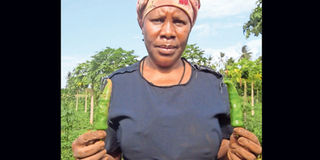Hot, red chilli serves farmer spicy profits

Dzendere Katana in her quarter-acre chilli farm in Kanamai, near Majengo Trading Centre, in Kilifi County. The crop does well in loamy, non-acidic, well-drained soils, which are also ideal for capsicum growth. PHOTO | CHARLES ONGADI | NMG
What you need to know:
- Chilli does well in Kilifi and other parts of the Coast but many farmers do not invest in the crop.
- To grow the crop, she first plants the seedlings in the seedbed and tills her land and then applies manure to the soil.
- Once the seedlings reach 8-10cm tall, she transplants them to the already prepared farm.
- For a farmer to get good money, the crop must be planted where there is adequate sunlight and the temperature shouldn’t drop below 150C.
Dzendere Katana’s quarter-acre chilli farm in Kanamai, near Majengo Trading Centre, in Kilifi County, hosts a lush green crop.
Dzendere got into chilli farming a decade ago without knowing where she will find market, but years down the line, she does not regret it as she counts her profits.
“Chilli does well in Kilifi and other parts of the Coast but many farmers do not invest in the crop,” says Dzendere, 65.
She has divided her farm into portions, so that she can grow the crop all-year-round.
“I transplant my seedlings to the portions at various times so that they can mature at different period, enabling me to harvest throughout.”
To grow the crop, she first plants the seedlings in the seedbed and tills her land and then applies manure to the soil.
“I start with raising beds a metre wide and apply compost manure and mix it thoroughly with the soil. I then make drills across the beds of about 10cm apart. I cover my seeds lightly with the soil and mulch the beds and wait them to germinate,” says Dzendere, a mother of six children.
Once the seedlings reach 8-10cm tall, she transplants them to the already prepared farm.
“One should not delay the transplanting as this makes roots to dry affecting growth of the plant,” says Dzendere, who has a borehole from where she sources her water.
Chilli takes a shorter time to mature, one of the reasons Dzendere who grows the Mexican Serrano variety, was attracted to the crop.
GET CERTIFIED SEEDS
“One to two weeks after transplanting, the crop begins to flower and matures after 21 days. The harvesting lasts four months or more if the crop is well maintained.”
She harvests the crop twice a day, getting at least 45kg per harvest, and sells a kilo at Sh40 to vegetable traders who come to pick from her farm, tourist hotels and a supermarket.

Dzendere works in the chili farm in Kilifi. The crop does well in the county and other parts of the Coast but many farmers do not invest in it. PHOTO | CHARLES ONGADI | NMG
However, many believe chilli farming is free of pests and diseases due to the nature of the crop. But that is not case, according to the farmer as her major problem is bacteria wilt.
Philip Charo, a retired agriculture officer in Kilifi, notes that the crop is a great source of vitamins C, A, B complex and minerals like iron, potassium and magnesium.
“For a farmer to get good money, the crop must be planted where there is adequate sunlight and the temperature shouldn’t drop below 150C.
The crop does well in loamy, non-acidic, well-drained soils, which are also ideal for capsicum growth.
“Farmers should also get certified seeds to avoid challenges which may arise from uncertified seeds. Anthracnose and bacteria wilt are some of common diseases but root-knot nematode pest can only cause problem in poor sandy soil. It is advisable to add organic matter before planting.”
All ripe red chilli should be harvested as soon as they appear and only mature, deep red fruits of length not less than 2cm should be picked without stalks.
“It is advisable to pick the fruits during the day after dew evaporates from the plant and the picking continues for three to four months.”




